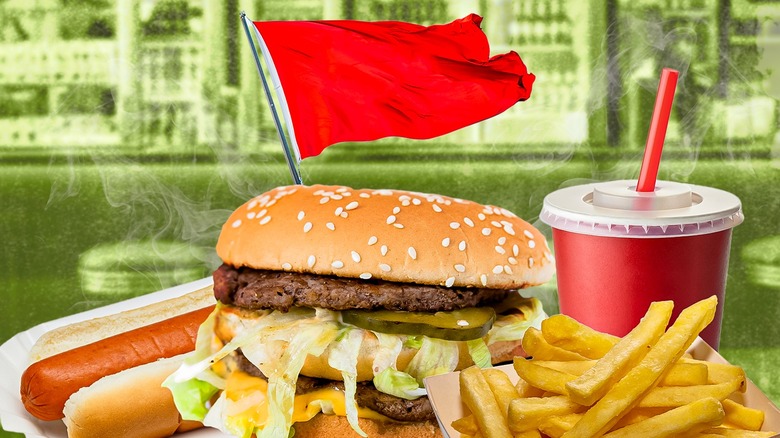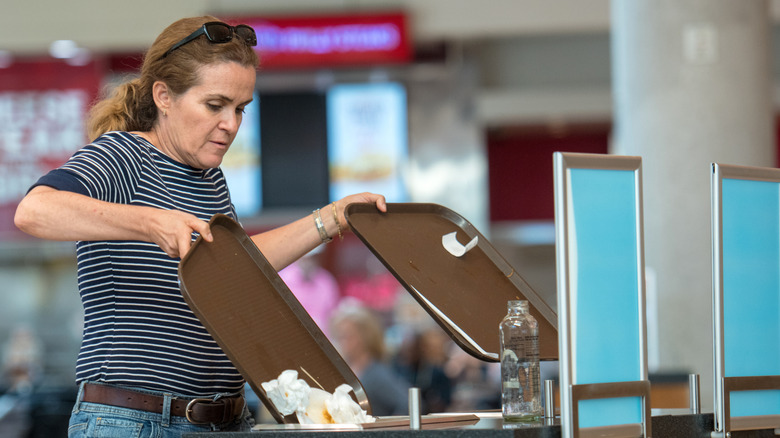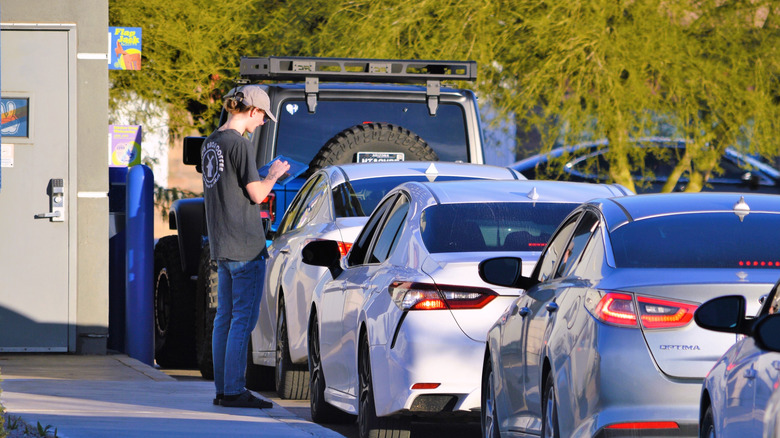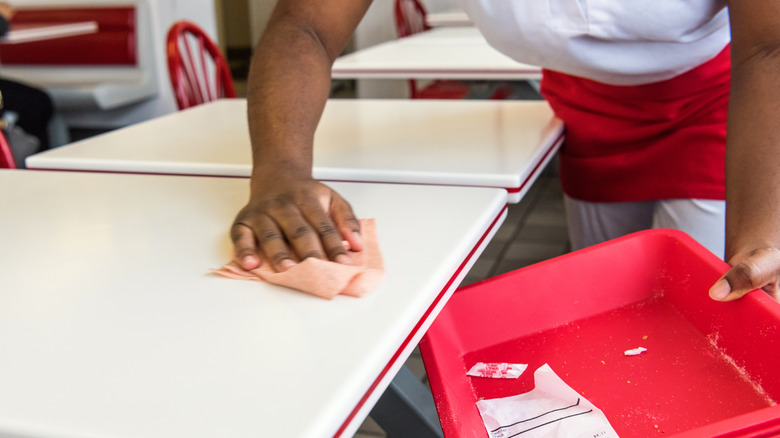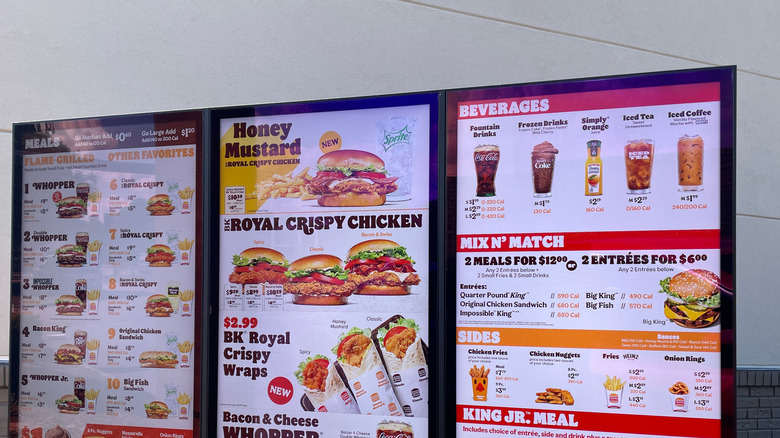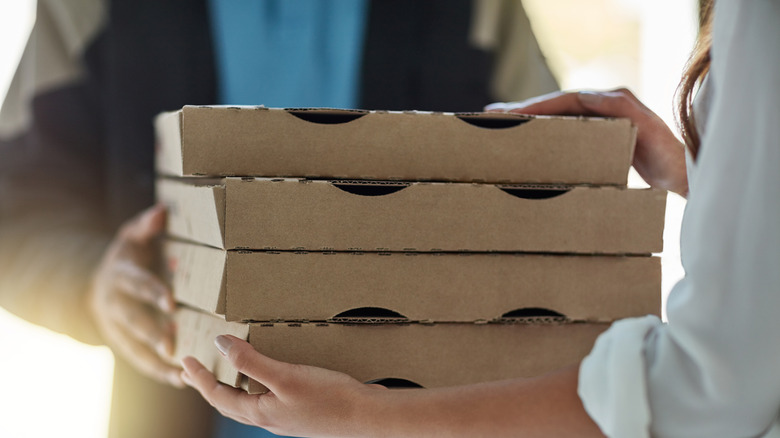13 Fast Food Red Flags That Should Send You Running
Fast food isn't fancy, but doesn't it hit the spot? Filling your maw with a Double Quarter Pounder and fries is as easy a feat in cities as it is rural towns and deserted highways, and with a consistent menu, we can expect delicious grub every time. That being said, drive-thru chains don't always deliver on the same standards. Signs of a bad restaurant are glaring as it is, but fast food's low-brow reputation (in comparison to the sleeker fast-casual restaurant) can blur the lines of what's an acceptable experience. Just because your meal is greasy doesn't mean franchises should get away with a sloppy dining environment.
Knowing whether that burger joint or chicken shack is a well-oiled machine demands keeping your eyes peeled for warning signs. Whether you're on the road or desperate for a bite, an informed mindset will help you save your dollars for a superior outing. Certainly, every conceivable sin won't be accounted for — the quick-serve realm is ripe with potential disasters — but we've pulled the biggest faux-pas that should send you running. Touching on dubious hygiene, atmosphere, and questionable service practices, review these 13 red flags for your next takeout treat.
There's always a bad smell
Breathing in a nice, lung-filling whiff is mandatory when trekking to your fast food spot of choice. In fact, we'd do it before taking a look at the menu. A putrid smell emanating from the restaurant isn't a matter to treat willy-nilly when setting to eat out somewhere. Interiors reeking of heavy frying oil, burnt food, and half-eaten remnants marinating in the trash turns stomachs, no doubt. Add in the heavy cleaner scent covering it up, and you've got a nasty miasma overriding the will to stay in line and complete your transaction at the register.
Regardless of the stench's source, a bad smell is an omen of worse issues hidden beneath the surface. The location might not be thorough in its cleaning efforts, including trash disposal, or could have issues involving wonky plumbing. Not to mention random spills on the floor or slacking on the disinfectant can be inconsiderate to guests. Who wants to sniff rotting lettuce or avocado skins while digging into their burrito bowl? Follow your nose. Unless a fast food chain is storing its guacamole like Chipotle, any gross odors deserve a kick to the curb.
The soda machines are dirty
We're not telling you to drop your fast food Pepsi because of health reasons; in this case, it's because restaurant soda fountains are dirtier than you think. Drive-thru places are notorious for dropping the ball on cleaning these contraptions, and the truth is, customers won't always notice the filth from sight alone. Soda machines are damp by their very nature, which means gunk is prone to accumulating on the stream nozzle, as well as the crevices within the appliance. If those organisms are left unchecked by staff members, there's no saying, hygiene-wise, how the rest of the establishment shapes up.
We're hard-pressed to feel comfortable buying soda (much less any food) if discolored residue is oozing from the machines. But the grossness isn't just internal — any surface of the soda fountain requiring touch can transmit germs. Think of how many patrons (or even employees) have pressed the same buttons in one afternoon. Unpolluted quarters should be the goal of every fast food chain, and to not fulfill this end of the bargain is a dealbreaker. Assuming fizzy refreshment is absolutely non-negotiable when enjoying your value meal, at least bottled drinks will be slime-free.
The food tastes funny
Of course, nothing about fast food is gourmet enough to win awards (though a rare number of drive-thrus have been awarded Michelin stars, believe it or not). Regardless, whatever you order should not only be edible, but taste as advertised. If your favorite chicken nuggets have an off-putting taste you can't pinpoint, the chain could be at fault for cutting an all-too-common corner. Unfortunately, franchises have a nasty habit of re-using the same supply of oil. Stale particles floating in the fryers can impart a strange funk into whatever's cooked in it. This means your French fries could be sizzling in a months-old solution, where impurities are affecting an otherwise fresh, delicious batch. Dull, sodden breading is one of the first clues chains are double-dipping.
While many franchises extend the oil's life for the purpose of sustainability, Entrepreneur reports, others may be less valiant in keeping old grease on deck. You won't always catch restaurants in the act of such a ruse. However, sharp senses can come in handy when gauging a fast food chain's fare. Is it charred, burnt, or just unappealing? Save yourself the bother.
Garbage bins are stuffed to the brim
Getting trash off the premises is a routine chore for restaurant maintenance — or at least it should be. If you swing by the garbage bins and they're bursting forth with crumpled wrappers, beware. That's a red flag that the employer doesn't treat sanitation as seriously as they should. Call us snooty, but the sight of overflowing waste isn't appetizing for anybody,. Visible garbage just doesn't bode well for the overall cleanliness of any joint worth the sodium spike.
Simply put, excess food scraps can attract unwanted scavengers. Pests, including insects and but also larger animals like rats (and not the cartoon chef kinds) pose the risk of spreading germs, and their unsavory presence can get eateries shut down. This is why it's crucial for any food establishment, especially drive-thrus, to not let trash get out of hand. When you think about it, a fast food environment generates loads of waste just from daily tasks of running the kitchen. At any time you don't spy a single custodian swapping out the bags (or tempering the trash odors with baking soda), run — it's the only good option.
You wait in snail-paced drive-thru lanes
One giveaway of a functioning fast food enterprise is the efficiency of its drive-thru. When the business demands slinging double-cheeseburgers to car after car after car, leisure time just won't be an option. Mind you, the average patron doesn't want to wait longer than five minutes for their order to come out, as findings from CivicScience showed, so workers need to move quickly to serve every person pulling up to the window. What happens when the takeout lane stalls and vehicles are stuck, inching slowly in a fender-to-fender flurry? Satisfaction goes down the drain. Complaints over snail-paced lanes are a death-knell for future visits.
Depending on the region, some franchises are simply just busy, and the drive-thru lane will reflect that — there's no stopping the swell when the lunch rush is in swing. On an otherwise normal day though, there are tell-tale clues explaining the grid-lock. Patrons can weed out bad locations by whether or not the store is properly equipped with staff. When two crew members in the back are confronted with commuters snaking around the block, they will struggle to meet lightning-speed standards no matter how automated the work is.
The burgers and fries never come out hot
Nothing deflates an appetite more than finding greasy American grub chilled to the bone. Your cheeseburger's cheese isn't really melted, and the fries, normally crisp and steaming from the paper cup, are a soggy, limp pile. What gives? Lukewarm food seems out of place for fast food restaurants, where heating lamps reign supreme, so diners ought to be concerned when they receive a meal that's devoid of warmth. It's a red flag that franchises aren't diligent in storing items the right way. Procedures outlined by the USDA refer to 140 degrees Fahrenheit as the minimum temperature to keep hot foods safe. Not only that, but the items only have about two hours to linger until it's time for them to be thrown out.
Drive-thrus assemble their fare in bulk, which obviously keeps service speedy both in and out of the restaurant's perimeters. It isn't always clear how long your chicken burger's been sitting out until an employee bags it on the line. For example, maybe a previous guest bought it, but staff forgot to put it in their order. Paving the way for ill customers under its roof is never a promising sign of an eatery to be trusted.
The bathrooms are far from squeaky clean
Even if we don't expect a fast food restaurant to commit to high levels of service, pristine restrooms shouldn't be that much of an ask. It's just common sense that an unclean bathroom is going to turn off customers, making them walk out as quickly as they walked in. Encountering a filthy toilet or grimy sink top isn't indicative of a hygienic environment, especially where food is being prepared in the next room over. Cooks need a space to soap up after handling raw meat, don't they? And won't workers need to take bathroom breaks? Asking these questions says all we need to know about the importance of a tidy space.
Maybe you don't think about the restroom when you grab takeout. You'll only be in the store temporarily, assuming you step into the restaurant at all, and figure whatever muck is soiling the place can remain out of sight and out of mind. Don't ignore it. Keeping these amenities sanitary is a major tell that the franchise values the guest experience. To neglect cleaning this area isn't just a red flag, but a five-alarm crisis.
The menu selection is all over the place
Having access to a large swath of cuisines is one of the many appeals of dining out. But when it comes to takeout, simplicity is preferred to a zillion possibilities. A drive-thru franchise hustling out extensive choices with no overlap doesn't inspire much confidence in quality. Maybe the fried chicken joint can be trusted for its breast and wing baskets, but that doesn't mean the quesadillas, roast beef sandwich, or empanadas with verde sauce at the sidelines will shine at an equal caliber.
On a regular basis, customers are most likely ordering from the core lineup — in other words, the dishes the chain is best at. Franchises know this, which explains the perennial graveyard of discontinued menu items patrons won't get back. Those cod morsels for the fish tacos will probably sit in the freezer until someone walks in and takes the plunge, but when that moment comes is a mystery. Without mincing words here, notably the menu lacks curation, where none of the ingredients seem to go with each other, and do not appear in enough menu items to seem thoughtfully-placed. It's a smorgasbord, which sounds appealing but might disappoint in the long run.
Employees constantly use soiled dish rags on the tables
For the minority still ordering their combo meal to stay, watching out for this next red flag is a must. At some point, employees will stroll through the dining room wiping things down — dirty tables, chairs and the like — which implies some semblance of proper hygiene. They're cleaning, which seems like something restaurants are supposed to do, except if the dish rag is soiled and stinking of a sweaty locker room. Re-using the same tattered wash cloth isn't a pragmatic tactic for actually sanitizing the premises — by contrast, those sticky surfaces will only be more questionable.
Germs take root in moist environments, and to no surprise, a damp towel is one they'll take to immediately. Per the American Society for Microbiology, washcloths can spread around bacteria that's lodged in the fibers (via USA Today). Those organisms are sneaky, and because they're prone to sticking around in the material, it isn't improbable for guests (and the drive-thru crew) to wind up getting ill. Sure, the dampened terry cloth might not ring any alarms — not at first — but waiting until the scent hits your nose means it's already too late.
The restaurant's health scores are poor
Forget French fries, this next red flag is slinging food-borne illnesses. When there's a poor health score posted on the window, it's doubtful any diner would risk taking chances by eating there. Many states requires dining establishments of all stripes to display their health inspection results to the public, and less-than-pretty verdicts (if it doesn't close the doors as a result), is always a tad suspicious. Any grade that's not an obvious pass? No need to give it the old college try when the option of speeding away from the parking lot is right there.
Potential infractions consist of a whole range of behaviors, some more serious than others. Still, many of the no-nos constituting a poor health inspection showing round out the most serious red flags of the bunch. Per Tulane University, locations can get dinged for alarming violations, including skipping regular hand-washing, leaving food in the danger zone, or housing cleaning chemicals in areas where ingredients are present. It's just bad news any way you slice it. Furthermore, a rodent problem or roach infestation not only invites negative reactions from the public, but can materialize into bigger scandals — think outbreaks of E.Coli, salmonella, and other pathogens.
The restaurant has disorganized, hard-to-read menus
Deciding what to order offers enough stress on its own, but try throwing in a menu with flashing graphics and text that's squint-inducing to the point of unreadable. Disorganized menus fail to demonstrate an affinity for good marketing or cater to drawing in customers. When a menu board requires mental energy to decode the food lineup, who can blame anybody for abandoning the place and going somewhere that knows its audience? This can be an issue at the drive-thru in particular, since screens exposed to the outside elements will look worse for the wear. A crack in the screen, harsh glare, and glitching images doesn't fare well for a repeat takeout run, at least from a location guilty of it.
With a better layout for ordering, diners would probably feel more motivated to return, especially if they're not having to twist their neck to view the entire selection They might not hesitate to add more to their purchase, tacking on yummy extras like fast food apple pie. Transparent, easy-to-read menus win every time, and they”ll never steer customers towards the exit.
You often get the incorrect order
It's a story we live through like "Groundhog's Day." Your order is amiss, and it's not looking good. Shouldn't there be three crunchy tacos and a burrito, not three soft tacos? And where's that burrito you asked for, anyway? Fumbling meals is one of the realities of drive-thru service. There's a high volume of nearly-identical items, and staff have to juggle them all simultaneously while navigating a hectic shift. While the occasional mix-up isn't a big deal, locations have an incentive to nail every request on the assembly line. Doling out incorrect entrees frequently hints at a troubled operation.
For one, crew members get slammed and might not have enough labor to handle all the orders. Miscommunication, hasty decision-making, not to mention overload between dine-in and delivery orders, contribute to the issue. Frankly, it's never a bad idea to examine your sack before zooming off, but it's not to say that franchises don't have a part to play in getting things right. Chick-Fil-A, although the slowest fast food chain, gets over 90% of purchases correct the first time around as of this publication. Lower-performers could learn a thing or two from its example.
Locations are constantly closed
Closed already? A Golden Arches with lights out at three in the afternoon is a weird, dystopian sight. Sometimes we can point to an unexpected issue for the impromptu hiatus — after all, grills break down, power outages occur, etc. The problem arises when the location in question closes frequently, often out of the blue and for extended lengths of time. Unless it's a company holiday, a typical chain will follow standard business hours. Irregular schedules demonstrate that the eatery is struggling to keep all hands on deck, burying problems bigger than the hand-written excuse taped to the door.
Franchises, certainly, are awarded a little independence in how to run their stores, but it's easy to tell when other factors are obstructing the business. Managers might not order enough stock from suppliers, resulting in shortages of popular items. Or, they fail to retain employees for the long haul. Don't forget, the turnover rate among workers can determine a location's performance and vitality — many hires will bail within three months, according to a 2022 HourWork report (via Restaurant Dive). Without a full staff to steer things, the hierarchy crumbles, leading to once-thriving establishments shuttering their doors indefinitely.
